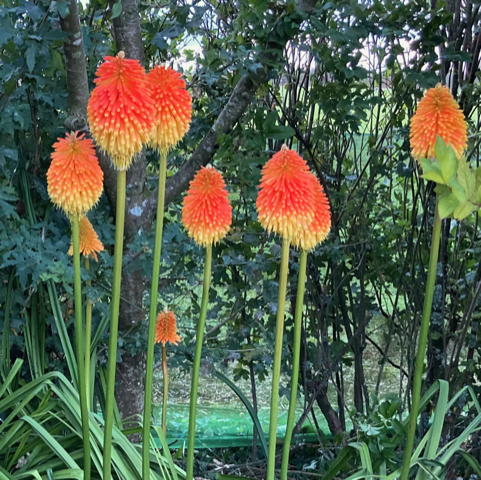Wasn’t February a wild month? Certainly for the second half! I hope not too much damage has been done around the Roseland, however it’s hard not to notice freshly cut tree stumps lining the roads.
March, on the other hand, should see a shift in the rhythm of the garden. The soil is beginning to warm, and any period over 10 degrees C for a little while will awaken the slugs and bring them out for an early meal (I’ve already seen one or two).
Plants begin to feel the sun this month and each day could bring a new twinkle of colour to bare stems such as early flowering cherry trees, Japanese quince and viburnum. Meanwhile the ground is decorated with many shades of spirit-uplifting spring flowers.
 Chaenomeles x superba ‘Crimson and Gold’
Chaenomeles x superba ‘Crimson and Gold’
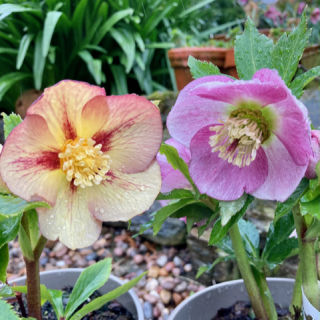 Meanwhile last month was hellebore month. Hidden in plain sight are a group of people obsessed with these hardy winter-flowering plants – hellebore-philes? Hellephiles? Much like galanthophiles with their snowdrops, but cheaper! This year I was lucky enough to secure a couple of Ashwood garden hybrids and had a successful trip to Bosvigo hellebore day in Truro
Meanwhile last month was hellebore month. Hidden in plain sight are a group of people obsessed with these hardy winter-flowering plants – hellebore-philes? Hellephiles? Much like galanthophiles with their snowdrops, but cheaper! This year I was lucky enough to secure a couple of Ashwood garden hybrids and had a successful trip to Bosvigo hellebore day in Truro
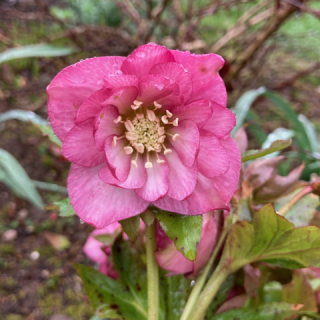
Trees and shrubs
If you have the beautifully coloured stems of dogwood in your garden for winter colour, cut them back now so that the new stems produced this summer will brighten your garden next winter.
Following the usual rule of thumb for pruning after a shrub has flowered, now is the time to give forsythias a trim. Although a plant that has perhaps gone out of fashion in recent years, there are still a few around! Mahonias can also be pruned at this time. Cut back the longest stems if you want to prevent them becoming tall and a bit leggy.
Give lavenders a light trim, more of a gentle haircut, but don’t cut stems lower than any new growth present or the stem will die. Lavender can become straggly and woody with age so it is always worth considering whether to replace the plants in late March or April with new ones if they are past their best.
Keeping your fingers crossed that we don’t have any sudden spells of snow in March, prune fuchsias now. You can take out old stems really low down, and perhaps give the whole plant a shear over to maintain a manageable size and a good shape. The same goes for spirea.
You can even move shrubs and trees this month, providing they are still small enough. Make sure you take plenty of the established root ball with it, then add some mycorrhizal fungi powder (Rootmore/Rootgrow etc) to the rootball itself before placing it into the new (square) hole. Provide a support stake placed at 45 degrees to the stem/trunk if necessary to stop the roots being rocked by the wind in their new hole. Water well for the whole of the first year.
Then put the kettle on, take a step back and spend a minute admiring any stunning magnolias that are in flower this month. It always amazes me how a tree, empty of leaves, can produce such large, bold and sturdy flowers able to withstand early spring storms. There are some stunning mature magnolias in the churchyard at St Just in Roseland.
Herbaceous borders
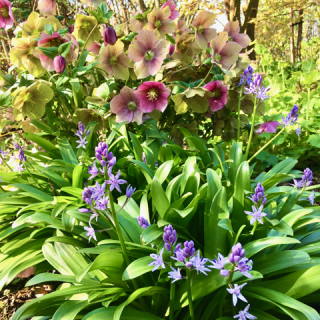 Work begins in the herbaceous borders this month! Spring flowering borders may well already be looking great and full of colour – pulmonarias, daffodils, early tulips, crocuses, primroses, bergenia, anemones, euphorbia, overwintered forget-me-nots are just a handful of the tough little beauties which burst into life this mon
Work begins in the herbaceous borders this month! Spring flowering borders may well already be looking great and full of colour – pulmonarias, daffodils, early tulips, crocuses, primroses, bergenia, anemones, euphorbia, overwintered forget-me-nots are just a handful of the tough little beauties which burst into life this mon
Cut down any dead stems from last year if you haven’t by now. Trim back last year’s penstemon stems, cut any leftover grasses before they begin growing and clear away any debris recently blown across the borders by all of the named storms we had in February.
Later flowering, summer plants can be lifted and divided now. If you can avoid your spring treasures in the border, then lift whole clumps of phlox, red hot pokers (kniphofias), day lilies (hemerocallis), Iris siberica, hosta etc. now. Place the root clump on a firm surface, take a spade or a sharp knife, or even a small saw, and cut the root into pieces. Make sure there are shoots on each section of root, then replant the sections you want to keep. This is a great way to spread the same plant over a larger area or to use it in other places in the garden without buying new plants. Otherwise dividing the plant will prevent it from outgrowing its space and from becoming congested which will reduce its flowering power.
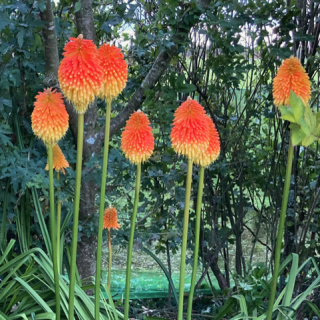 Kniphofia rooperi summer 2021
Kniphofia rooperi summer 2021
Other plants don’t form quite such dense roots, such as asters and rudbeckias, and can be dug up and the roots teased apart by hand.
More tender herbaceous plants can be started indoors in pots now, such as dahlias, cannas and ginger lilies. These will often do just fine if left in the garden over winter but if you have bought new roots or rhizomes this year, then either start them indoors now or plant them outside when the soil is warmer.
Sow hardy flower seeds outside from March, and tender seeds indoors so the plants are big enough to be ready to be hardened off in late April or May.
Aquatic plants can be repotted in March too, wait until they start to grow again before carefully lifting them from the pond without disturbing the wildlife too much, which will be in full swing by now.
Keep on top of those weeds before they start to flower! Ephemeral weeds such as bittercress, which I’m sure is in every single garden on the Roseland, will be flowering by now so catch them before they set seed. (Ephemeral plants can have several life cycles per year). Having a really good weed through a couple of times in the spring will be enough to make it easy for the rest of the year, until the autumn flush.
The other important job this month, especially if you have the especially irresistible flavours of delphinium, hosta and lupin in the garden, is to start applying your slug defence of choice, be it wool pellets, copper strips, crushed eggshell, nematodes, organic pellets or a glass of beer. This is especially effective if refreshed when you know the coming night will be mild and mizzly.
Vegetables
The vegetable garden is just as busy as the flower garden this month. The same problems apply – weeds and slugs! Ironically, a good solution to weeds, of laying a covering over the soil to smother the weeds also provides a rather good hiding place for the slugs and snails and helps to warm the soil nicely for them.
Plant early potatoes, onion sets and garlic. Start sowing carrots, parsnips, beetroot, brassicas, lettuce and leeks outdoors, although the more sheltered the better. However it still might be worth sowing indoors in modules so the plants are a good size before they go outdoors to help them resist all the weather and the local wildlife may have to throw at them. Don’t forget to rotate your vegetable patch to not grow the same type of veg in each section each year.
Finally, I shall be providing the local feathered inhabitants of our garden (and it seems of several fields around) with the finest wild bird seed to keep their energy up whilst nest building. They are also very partial to a few clumps of fluffy dog hair from the brush after the molting hounds have been groomed. I think our sparrows have the softest nests in the area!
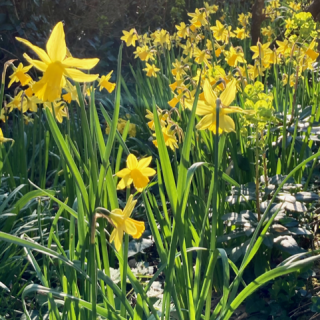 Once again, I have my fingers crossed for a relatively normal, not too mild or too dry, month of March brightened with the merry cheer of yellow daffodils.
Once again, I have my fingers crossed for a relatively normal, not too mild or too dry, month of March brightened with the merry cheer of yellow daffodils.
Caroline Kenzie
Papaver Garden Design and Tuition (link to go on this text)

